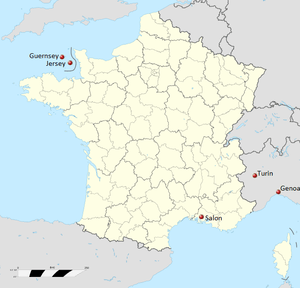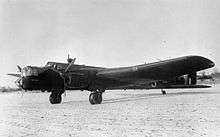Haddock Force
| Haddock Force | |
|---|---|
| Part of the Battle of France | |
 Map showing the location of bases in the Channel Islands and at Salon and the target cities of Turin and Genoa | |
| Type | Bombing campaign |
| Location |
Salon, France 43°36′23″N 005°06′33″E / 43.60639°N 5.10917°ECoordinates: 43°36′23″N 005°06′33″E / 43.60639°N 5.10917°E |
| Objective | Disruption of the Italian war economy |
| Date | 11–17 June 1940 |
| Executed by | RAF Bomber Command |
| Outcome | Allied failure |
Haddock Force was a Royal Air Force group of bombers dispatched to airfields in southern France, with the mission of bombing northern Italian industrial sites, following the Italian entry into the Second World War. When Italy declared war on 10 June, the plan was put into effect but at first, the local authorities prevented the RAF Vickers Wellington bombers from taking off. Whitleys flying from England via the Channel Islands made the first raid on the night of 11/12 June 1940.
After negotiations between the French and British governments and directives from Paris to the authorities in the south of France, the Wellingtons flew back. Operations commenced on the night of 14/15 June but all but one of the eight bombers returned without bombing due to bad weather. Eight Wellington crews tried again the next night and six claimed to have bombed Milan; the raid was the last by RAF Bomber Command from French bases until 1944.
Background
Wireless decrypts by the Government Code and Cypher School at Bletchley Park gave the Allies about a month's notice of an Italian declaration of war.[1] The Battle of France was nearing its final phase when intelligence reports suggested that Italy was on the brink of entering the war on the side of her Axis partner, Germany. There were few resources available to Britain which could be used to support France against the Italians, with the exception of Royal Air Force (RAF) Bomber Command. The Supreme War Council resolved on 31 May that if war was declared, industrial targets and oil plants in the northern Italian cities of Turin and Genoa, were to be attacked as soon as possible. Armstrong Whitworth Whitley bombers could reach their targets from the Channel Islands, while the shorter-ranged Vickers Wellingtons would have to refuel in the south of France and the French Air Command made available the airfield outside Marseilles at Salon-de-Provence and another one nearby.[2] The headquarters of 71 Wing was sent to the Marseilles area on 3 June to prepare reception and refuelling facilities for the British bombers, which were ready on the outbreak of war on 10 June.[3]
Operations
11–17 June

Italy declared war at midnight on 10 June 1940 and a detachment of Wellingtons from 99 Squadron, part of 3 Group, Bomber Command, left England for France and arrived at Salon at 15:30 hours on 11 June. French fighters based near the Italian border had been sent north against the Luftwaffe and despite the agreement to attack Italy, the French civilian authorities decided that bombing Italy would provoke attacks on the huge petrol dumps on the Étang de Berre 25 km (16 mi) north-west of Marseille; retaliation against civilians which could only fall on French cities and was to be avoided.[4]
General Jean-Baptiste-Benjamin Laurens, the commander of Zone d'opérations aériennes des Alpes (ZOAA) asserted that the French government opposed the raid and refused to allow the attack from bases under his command.[5] While the bombers were refuelling, the force commander, Group Captain R. M. Field, received a telephone call from the commander of the local French bomber group. The commander told him that Italian targets were not to be attacked but shortly afterwards, Field received orders from the Air Ministry in London that the aircraft should take off as planned. There was a flurry of telephone calls from various French authorities, culminating in a call at 21:45 hours from the Chief of the Air Staff, General Joseph Vuillemin to the headquarters of British Air Forces in France (BAAF, Air Marshal Arthur Barratt).[6]

Field followed the orders from the Air Ministry in Britain and Barratt in the evening. Around 00:30 hours as the first Wellington taxied into position for take-off, French troops blocked the runway with a line of lorries and carts; Field had no choice but to abort the mission and most of the Wellingtons returned to England the next day. On the evening of 11 June, the British diplomatic representatives in France heard that the French had stopped the British bombers from taking off from Salon and after strong protests Paul Reynaud, the French prime minister, agreed to order the French authorities to co-operate.[7]
Another 36 Whitleys from 10 Squadron, 51 Squadron, 58 Squadron, 77 Squadron and 102 Squadron had refuelled at the advanced bases on Jersey and Guernsey and were on their way to Italy. Severe storms and icing caused the majority of the aircraft to turn back and only 13 reached their targets at Turin and Genoa; two aircraft failed to return.[8][lower-alpha 1] After representations at the highest levels, the French authorities finally consented to raids on Italy and six Wellingtons each from 99 Squadron and 149 Squadrons returned to the south of France. Eight aircraft left on the evening of 15 June to bomb the Ansaldo works at Genoa.[9] Thunderstorms made navigation difficult; only one aircraft arrived over the target and the rest returned with their bombs. The following night, another attempt was made by nine Wellingtons but only five reached their objective.[lower-alpha 2] The French armistice negotiations prevented further operations.[8] The Allies were defeated and British bombers did not fly from France again until 1944, when they participated in the defeat of Germany.[9]
Notes
Footnotes
- ↑ Hinsley 1994, p. 59.
- ↑ Ellis 2004, p. 294.
- ↑ Richards 1974, pp. 145–146.
- ↑ Rowe 1959, p. 246.
- 1 2 Jackson 1974, p. 125.
- ↑ Richards 1974, pp. 146–147.
- ↑ Woodward 1970, p. 252.
- 1 2 Richards 1974, p. 147.
- 1 2 3 Jackson 1974, p. 126.
References
- Ellis, Major L. F. (2004) [1st. pub. HMSO 1953]. Butler, J. R. M., ed. The War in France and Flanders 1939–1940. History of the Second World War United Kingdom Military Series. Naval & Military Press. ISBN 978-1-84574-056-6. Retrieved 1 September 2015.
- Hinsley, F. H. (1994) [1993]. British Intelligence in the Second World War. Its influence on Strategy and Operations. History of the Second World War. abridged edition (2nd rev. ed.). London: HMSO. ISBN 978-0-11-630961-7.
- Jackson, R. (1974). Air War over France 1939–40. London: Ian Allen. ISBN 978-0-7110-0510-5.
- Richards, Denis (1974) [1953]. Royal Air Force 1939–1945: The Fight At Odds. I (pbk. ed.). London: HMSO. ISBN 978-0-11-771592-9. Retrieved 16 September 2015.
- Rowe, V. (1959). The Great Wall of France: The Triumph of the Maginot Line (1st ed.). London: Putnam. OCLC 773604722.
- Woodward, L. (1970). British Foreign Policy in the Second World War. History of the Second World War, Civil Series. I. London: HMSO. ISBN 978-0-11-630052-2.
Further reading
- Horne, A. (1982) [1969]. To Lose a Battle: France 1940 (Penguin repr. ed.). London: Macmillan. ISBN 978-0-14-005042-4.
- Petrella, Luigi (2015). Myth and Reality in the Fascist War: The Ministry of Popular Culture and Italian Propaganda on the Bombing of Civilians, 1938–1943 (PhD). Newcastle: Newcastle University. hdl:10443/3132. OCLC 951084302.
EThOS uk.bl.ethos.694370. Retrieved 3 June 2017.

- Terraine, J. (1998) [1985]. The Right of the Line: The Royal Air Force in the European War 1939–1945 (Wordsworth Editions ed.). London: Hodder and Stoughton. ISBN 978-1-85326-683-6.
- Warner, P. (2002) [1990]. The Battle of France, 1940: 10 May – 22 June (Cassell Military Paperbacks repr. ed.). London: Simon & Schuster. ISBN 978-0-304-35644-7.